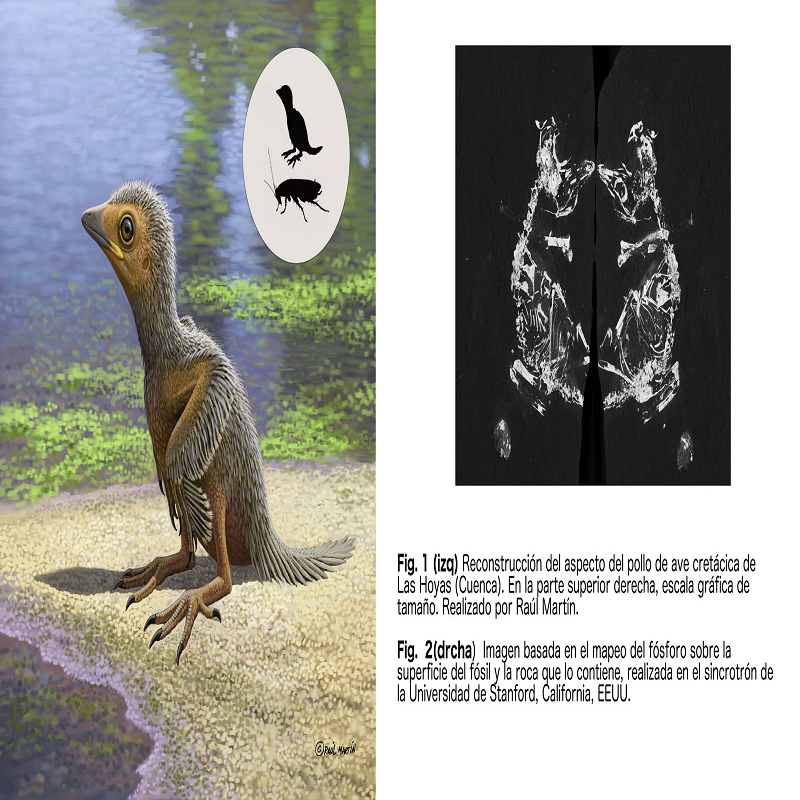
The 125 million-year-old fossil of a chicken reveals aspects of the growth of primitive birds

2018-03-06
An international team, where Universidad Autónoma de Madrid (UAM) participated, the Joint Palaeontological Foundation of Teruel-Dinópolis, the Spanish National Distance-Learning University (UNED) and the University of Malaga have presented in Nature Communications the fossil of a chick from the Cretaceous period found in the town of Las Hoyas (Cuenca province). It is one of the smallest fossil birds ever found and provides unique information about how primitive birds grew.
Over the last three decades, palaeontologists have gathered ever more accurate information about the origin and early evolution of birds. We currently know that a group of extinct birds known as Enantiornithes were already diverse and abundant in Cretaceous ecosystems more than 120 million years ago. We know many aspects of their origins and relationships, their lifestyles and even how they flew, but information about their reproduction and growth is still scant.
The town of Las Hoyas in the province of Cuenca is an exceptionally well-preserved archaeological site that, since it was discovered in the 1980s, has provided a lot of information about wetlands from 125 million years ago. The fossils found, moreover, have enabled scientists to clarify the evolutionary history of various organisms, particularly with respect to their understanding of the early evolution of birdlife.
Now, Nature Communications journal has presented the study of a fossil from an Enantiornithes chick from Las Hoyas, recently hatched from the egg. The specimen, a little more than two centimetres in length, is one of the smallest fossil birds known and provides unique information about the ossification of skeletons during the growth of these primitive birds.
The fossil was studied by a multidisciplinary team of researchers from the Universidad Autónoma de Madrid (UAM), the Joint Palaeontological Foundation of Teruel-Dinópolis, the Spanish National Distance-Learning University (UNED) and the University of Malaga, the Natural History Museum in Los Angeles (USA), the University of Manchester (United Kingdom), the University of Uppsala (Sweden), the European Synchrotron (France) and the College of Charleston (USA).
Using leading-edge technology based on the residual energy from particle accelerators (synchrotrons), minute details of the fossil could be captured in three dimensions. Thanks to this, it was possible to reconstruct, in detail, the chick’s bone ultra-structure, on the one hand, and, on the other hand, to produce maps of the chemicals present in the fossilized bones.
Computerized micro-tomography
At the synchrotron in Grenoble, France, the small bird’s ultra-structure of minuscule bones was reconstructed using computerized micro-tomography. “This way we know that the bone tissue in the humerus, the longest bone in the wing, has the typical characteristics of a very young bird. Everything points to this chick having died almost as soon as it came out of its shell,” describe the scientists.
“The virtual analysis of the bone structure,” they explain, “shows the presence of a single external layer of bone and the absence of growth stoppage lines, which would indicate that the skeleton, like any new-born, was growing very fast. In addition, its head is enormous compared to its body and it has large eye sockets that would house also relatively large eyes, just as would be expected in an individual in its first stages of growth.”
As part of the project, the researchers also analysed the differential pace of the skeleton’s ossification. The results show that bones of such great importance for flight as the sternum were also very little ossified at such an early age.
Another relevant point, according to the scientists, is the information that this specimen provides about the disappearance of the typically dinosaur-like tail and its transformation into the short bone called pygostyle of modern birds. The skeleton has preserved part of a tail that has 10 free vertebrae. Adult Enantiornithes only have eight free vertebrae in their tails, whereas the rest melded into a structure called pygostyle (just like in modern birds). Although the fossil from Las Hoyas does not retain the end of the tail, the large number of free vertebrae probably suggests that the formation of the pygostyle took place in Enantiornithes after the chicks were born.
Geo-chemical maps
On the other hand, at the synchrotron in the University of Stanford (California, United States), maps have been produced to show the chemicals in the fossilized tissues.
Phosphorus forms part of bone composition and mapping its presence enables the precise delimitation of the outline of the bones in the diminutive skeleton. The phosphorus found in the bones of the chick from Las Hoyas is present at concentrations very similar to those found in the skeletons of modern-day birds, indicating the enormous potential the site at Las Hoyas has for preservation.
In addition, the specimen provides information about the pace of growth of these primitive chicks. As the researchers explain: “It has been posited that Enantiornithes, in general terms, were nidifugous, i.e. they left the nest soon after they were born. It is true that the fossil found in Las Hoyas represents a specimen that would still be incapable of flying, due to the incomplete ossification of the sternum, but the presence of feathers on the fossil indicates that it might be a nidifugous bird that had not yet developed its skeleton and muscles sufficiently to enable it to fly.”
See full notice in the download area

